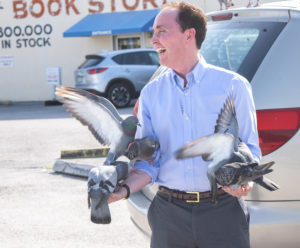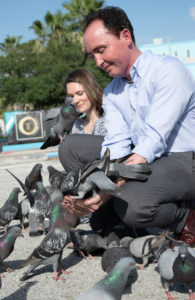
Pigeons are “way smarter than I had thought,” says Raymond Hinst.
By ANNA BRYSON
USFSP Student Reporter
ST. PETERSBURG – For more than 80 years, people have flocked to Haslam’s, the iconic bookstore that calls itself “St. Petersburg’s favorite rainy day attraction.”
Turns out that pigeons flock there, too.
Twice a day, around 10 a.m. and 5 p.m., dozens of the birds descend on the parking lot to envelop a man toting a 40-pound bag of bird seed.
From their perches on his hands, arms, shoulders and head, they coo as he dispenses the goodies.
Depending on the day, their benefactor is either Ray Hinst, who owns the store with his wife Suzanne, or their son Raymond – the third and fourth generations of the family that founded the famous store in 1933.
This ritual began about three years ago. Ray was filling a bird feeder outside the store at 2025 Central Avenue when one of the pigeons jumped into his hand.
Intrigued, Raymond began to read up on pigeons, study their habits and become an admirer of the store’s feathered neighbors.
To a lot of people, the pigeons that abound in St. Petersburg are a nuisance. They flap their wings loudly, defecate on sidewalks, benches and cars, and intimidate some songbirds.
But Raymond Hinst isn’t buying it.
He marvels at how pigeons navigate, using road systems as directions, and he quotes scientists who say the birds can count and recognize themselves in a mirror. They typically mate for life.
“It’s amazing how there’s this whole little world of these intelligent beings that we don’t even notice,” he said.
“Their eyes were way more intelligent up close, so it seemed like there was a lot more going on under the hood for those pigeons, and they were way smarter than I had thought.”
The pigeons soon learned Hinst’s routine. Every day at the appointed hours, they gather in Haslam’s parking lot to wait for him.
They even recognize him, he said. “It didn’t matter what car I was in, what I was wearing, whether it was a hat, or a pirate costume, or fake hair. They knew it was me, and they would come and fly out to the car when I got out of it.”

Customers like Bianca Miller (left) often help Hinst with the twice-daily feedings.
Martha Coit, a Haslam’s employee, said that when Hinst wasn’t there one day, the birds wandered around the parking lot, then came right up to the glass door and peered inside, as if looking for him.
The pigeons even recognize him away from bookstore, Hinst said. If they see him downtown, they will come and sit next to him.
Once Hinst established a relationship with the pigeons, he began inviting customers – especially families with children and people with special needs – to help with the feeding.
One of his regular customers is a teenager with limited mobility who loves to put the seeds in her lap so the pigeons land on her.
“Because it was an amazing moment for me, I would like other people to have that moment and then appreciate and have a much deeper experience with all the nature that’s around them that maybe they’re conditioned not to notice or to ignore,” Hinst said.
The pigeon, also known as the rock pigeon and rock dove (scientific name: Columba livia domestica), is a short, tubby bird that is often dark gray with a green-purple iridescence at the neck.
“Each one has their own little personality,” Hinst said.
His favorite is the smallest but smartest pigeon in the flock, he said.
Its name? “Hope,” after the Emily Dickinson poem, “‘Hope’ is the thing with feathers.”
